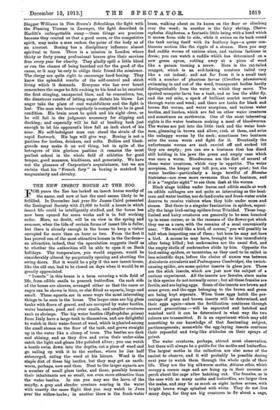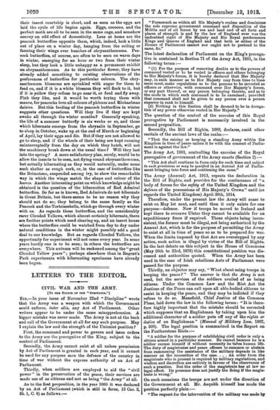THE NEW INSECT HOUSE AT THE ZOO.
FOR years the Zoo has lacked an insect house worthy of the name, and now at last the need seems likely to be fulfilled. In December last year Sir James Caird presented the Zoological Society with 21,000 to build a house in which insect life could be intelligently studied, and the house has now been opened for some weeks and is in full working order. More, no doubt, will be on view in the spring and summer, when the tide of certain forms of insect life is fuller, but there is already enough in the house to keep a visitor occupied for more than an hour or two. From the first it has proved one of the most attractive houses in the Gardens— so attractive, indeed, that the speculation suggests itself as to whether the authorities will be able to open it on Bank holidays. The temperature, you would suppose, would be considerably altered by perpetually opening and shutting the swing doors. But it would be a pity if the new insect house, like the old one, had to be closed on days when it would be so greatly appreciated.
" Insects " in this house is a term covering a wide field of life, from edible snails to peacock butterflies. On each side cf the house are alcoves, arranged either so that the cases or cages can be shown in tiers, or else fitted as aquaria, large and small. These aquaria are in some ways the moat interesting things to be seen in the house. The larger ones are big glass tanks with floors of gravel, and are occupied by water beetles, water boatmen, pond and river snails, and smaller creatures such as shrimps. The big water beetles (Hydrophilus piceus) from Italy have a large tank to themselves, and are delightful to watch in their water-forest of weed, which is planted among the small stones on the floor of the tank, and grows straight up in the water like a clump of trees. The beetles are dark and shining, and as they dive and swim their under-sides catch the light and gleam like polished silver; you can watch a beetle swim down into the depths, cut a piece of weed and go sailing up with it to the surface, where he lies half submerged, eating the weed at his leisure. Weed is the staple diet of these big beetles, but they may get an earth- worm, perhaps, now and then. Next to the larger aquaria are a number of small glass tanks, and these, possibly because their inhabitants are so small, are even more attractive than the water beetles. In one you may see the larva of the mayfly, a grey and slender creature soaring in the water with exactly the same flight that you may watch in June over the willow-herbs ; in another there is the fresh-water
louse, walking about on its knees on the floor or climbing over the weed ; in another is the fairy shrimp, Cheiro- cephalus diaphanus, a fantastic little being with a head which it moves from side to side, while it swims on its back round the tank oaring itself with its feathery legs—a queer con- tinuous motion like the ripple of a stream. Here you may find caddis worms of various sizes, and various fashions in dress; you can watch a caddis which has determined on a new green apron, cutting away at a piece of weed like a person turning a screw. Here is the rat-tailed maggot, which is an evil-looking creature tailed very like a rat indeed; and not far from it is a small tank with a number of phantom larvae (Corethra plumicornis) swimming in and out of the weed, transparent bodies hardly distinguishable from the water in which they move. The spotted mosquito larva has a tank, and so has the alder fly, and the red mite, a speck of brilliant scarlet moving fast through water and weed; and there are tanks for black and brown flat worms, and water scorpions, and various water beetles, and leeches, which are fed on other water creatures and sometimes an earthworm. One of the most interesting sights is the water boatmen making a meal of bloodworms. The worms are put into the little tank and the water boat- men, gleaming in brown and silver, rush at them, and seize the unhappy worms by the neck; sometimes two boatmen seize the same worm and fight for it. Eventually the unfortunate worms are each carried off and sucked till they are empty ; you can see a boatman that has dined still holding in his jaws the green and empty case which was once a worm. Bloodworms are the diet of several of these water creatures, which vary in appetite. The water scorpions, the keeper may tell you, are very quiet; but the water beetles—particularly a large bowlful of Bhantus bistriatus—are even more ravenous than the boatmen, and it is a "regular sight" to see them dash at the worms.
Black slugs hidden under leaves and edible snails at work on edible cabbages are not quite so interesting as the boat- men and water beetles, nor do land crabs and fresh-water crabs deserve to receive visitors when they hide under moss and stones. But there is a singular fascination in spiders, especi- ally the large bird-eating spiders from Trinidad. These long- limbed and hairy creatures are generally to be seen bunched up in some corner, or in the recesses of the flower-pot which they use as a cave, with the remains of a meal conveniently near. "He would like a bird, of course," you will possibly be told when inspecting one of them ; but here he may not have a bird. A mouse he may have, brought to him immediately after being killed ; but cockroaches are the usual diet, and the empty shells of cockroaches abide by him. Opposite the bird-eating spiders, or tarantulas, as they used to be called in less scientific days, before the choice of names was between Avicularia avicularia and Psalmopoeus Cambridgei, the twitch- causing spider, are some quieter insects in glass jars. These are the stick insects, which are just now the subject of a curious experiment. All the insects are females, since males in this species do not normally occur ; but all these females are fertile, and are laying eggs. Some of the insects are brown and some green, and the eggs belonging to the brown and green are being kept separate. When these eggs hatch the per- centage of green and brown insects will be determined, and their eggs again—since the fertilization continues through several generations — will be separated and hatched and watched until it can be determined in what way the two colours are transmitted. It is an experiment which may add something to our knowledge of that fascinating subject, parthenogenesis ; meanwhile the egg-laying insects continue their reposeful and twig-like attitudes on their sprays of privet.
The water creatures, perhaps, attract moat observation, but there will always be a public for the moths and butterflies. The largest moths in the collection are also some of the easiest to observe, and it will probably be possible during next year to watch them through the whole cycle of their life. They are the big silkworm moths, Attacus atlas, which occupy a corner cage and are hung up in their cocoons or perch about the cage after hatching out. The females, as is the case with so many moths and butterflies, are larger than the males, and may be as much as eight inches across, with bright brown wings splashed with white. They do not live many days, for they are big creatures to fir about a cage, their insect courtship is short, and as soon as the eggs are laid the cycle of life begins again. Eggs, cocoons, and the perfect moth are all to be seen in the same cage, and somehow convey an odd effect of domesticity. Less at home are the peacock butterflies opposite them, which, indeed, look a little out of place on a winter day, hanging from the ceiling or fanning their wings over bunches of chrysanthemums. Pea- cock butterflies, of course, are often to be seen on warm days in winter, emerging for an hour or two from their winter sleep, but they look a little unhappy as a permanent exhibit on chrysanthemums. As to this particular flower, they have already added something to existing observations of the preferences of butterflies for particular colours. The chry- santhemum blossoms are sprinkled with sugar for them to feed on, and if it is a white blossom they will flock to it, but if it is yellow they refuse to go near it, or feed and fly away. Pink they like, and it would be worth trying them with mauve, for peacocks love all colours of phloxes and Michaelmas daisies. But this feeding of the peacock butterflies in winter suggests other questions. Will they live if they are kept awake all through the winter months ? Generally speaking, the life of a summer butterfly is six weeks or so, and those which hibernate emerge from the chrysalis in September, go to sleep in October, wake up at the end of March or beginning of April, lay their eggs and die. But if they are not allowed to go to sleep, and if the wheels of their being are kept running uninterruptedly from the day on which they hatch, will not the machinery break down at the usual time ? Will they last into the spring ? A more satisfactory plan, surely, would be to allow the insects to be seen, not flying round chrysanthemums, but actually hibernating as they would naturally, under some such shelter as rough cork, or, in the case of butterflies like the Brimstone, suspended among ivy, to show the remarkable way in which the wings match the shape and colour of the leaves. Another interesting point on which knowledge might be obtained is the question of the hibernation of Red Admiral butterflies. So far as is known, Red Admirals do not hibernate in Great Britain, but there seems to be no reason why they should not do so; they belong to the same family as the Peacock and the Tortoiseshells, which go through every winter with us. As regards these butterflies, and the considerably rarer Clouded Yellows, which almost certainly hibernate, there are further points which need clearing up, and an insect house where the butterflies could be watched from day to day under natural conditions in the winter might possibly add a good deal to our knowledge. But as regards Clouded Yellows, the opportunity for experiment will not come every year. In some years hardly one is to be seen; in others the butterflies are everywhere. This autumn will be reckoned among the" great Clouded Yellow years" ; perhaps elsewhere than in Regent's Park experiments with hibernating specimens have already been begun.



























































 Previous page
Previous page